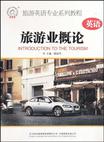旅游业概论
出版时间:2009-5 出版社:吉林出版集团有限责任公司 作者:戚国华 著 页数:178
内容概要
《旅游业概论》共有十二章,其主体可以划分为四大板块。第一大板块是对旅游业的整体把握,包括对旅游业的基本介绍,旅游组织机构及其相互间的关系,政府在旅游业发展过程中发挥的作用,旅游业发展对于一个国家和地区的经济意义等。在第二大板块中,本教材将从旅游消费者的角度对旅游过程进行阐述,包括旅游者的动机和表现(旅游者的动机是多方面的,甚至有一些动机连自己也没有意识到)及旅游过程中不同交通方式的特点等。在第三大板块中,本教材将从旅游从业者的角度来描述旅游管理及其服务,包括旅游组织的实务运作,旅游业的营销体制,旅游机构的特点及其职能等。在本教材的最后,也就是第四板块,将探讨旅游业对环境和社会的影响,旅游业的发展可能会带来一定的环境和社会问题,如果处理不好,这不仅危及旅游业自身的健康、协调和可持续发展,也会损害社会整体乃至全人类共同的利益,因此,有必要专辟一章进行分析论述。
书籍目录
Chapter 1 An Introduction to Tourism1.1 Tourism Definitions1.1.1 Towards an Agreed Definition1.1.2 Categories of Tourists1.1.3 Categories of Tourism1.1.4 Other Working Definitions in Travel and Tourism1.2 The Tourism Industry and Its Products1.2.1 Classification of the Tourism Industry1.2.2 Characteristics of the Tour1.2.3 Characteristics of the Tourism Products1.3 The History of Tourism1.3.1 Ttravel in the Middle Ages1.3.2 Travel from the Seventeenth to Nineteenth Centuries1.3.3 Travel in the Twentieth Century1.4 The Challenges of the Twenty-First CenturyChapter 2 The Structure and Role of Public Sector Tourism2.1 The Nature of Public Sector Involvement in Tourism2.1.1 Reasons for Public Sector Involvement2.1.2 Public Sector Roles and Functions2.2 The Goals of Tourism Policy2.2.1 Tourism Goals2.2.2 Constraints2.3 Tourism Legislation and RegulationsChapter 3 The Distribution Channels and Organizations of the Tourism Industry3.1 The Tourism Channel of Distribution3.1.1 The Producer3.1.2 The Intermediaries3.1.3 The Support Services3.2 Tourism Organizations3.2.1 Sectoral Organizations3.2.2 Destination Organizations3.2.3 Tourism Organizations3.3 Integration in the Tourism Industry3.3.1 Horizontal Integration3.3.2 Vertical Integration3.3.3 The Result of IntegrationChapter 4 The Economics of Tourism4.1 Economics of Tourism4.2 Overview of the Global Tourism Industry4.2.1 Development Status and the International Tourist Market4.2.2 Overview of Development in Major Countries and Regions4.3 Overview of the China Tourism Economy4.3.1 Present Situation4.3.2 Overview of Development in Major Countries and Region4.4 Economic Impact of Tourism4.4.1 Negative Economic Impact from Tourism4.4.2 How Tourism Contributes to Economic DevelopmentChapter 5 Tourist Motivation and Behavior5.1 Importance of Motivation5.2 Factors Influencing Motivation5.2.1 Internal Driving Forces5.2.2 External Influencing Factors5.3 Motivators and Facilitators5.4 The Consumer Buying ProcessChapter 6 Transport for Tourism6.1 The Role of Transport6.2 Defining Transport6.3 Transport System6.4 Transport Modes6.5 Aviation Transportation6.5.1 The Organization of Air Transport6.5.2 Airline Services6.5.3 Freedom of the Air6.6 Maritime Transportation6.7 Rail Transportation6.8 Road TransportationChapter 7 The Hospitality Sector: Accommodation and Catering Services7.1 The Characteristic of the Accommodation7.1.1 Definition7.1.2 Characteristics7.2 Ownership in the Accommodation Sector7.2.1 Individual Ownership7.2.2 Franchises7.2.3 Management Contract7.3 Management Practices in the Accommodation Sector7.3.1 Rooms Department7.3.2 Security7.3.3 Engineering7.3.4 Food and Beverage Department7.3.5 Marketing and Sales Department7.3.6 Accounting Department7.3.7 General Manager7.4 Classifying and Grading Accommodations7.4.1 Classified by a Star System7.4.2 Quality of Facilities and Services7.4.3 Classification of Hotels7.5 The Nature of the Demand for Accommodations7.5.1 Some Characteristics of the Hotel Product7.6 Location of Lodging Facilities7.7 Careers in the Accommodation SectorChapter 8 Visitor Attractions8.1 Definition8.2 Characteristics8.2.1 Rigidity of Attractions8.2.2 Instability of Demand8.2.3 Elasticity of Demand8.2.4 Seasonality of Demand8.2.5 Competition8.2.6 Distribution8.2.7 Other Special Characteristics8.3 Classification of Visitor Attractions8.3.1 Ownership8.3.2 Primary and Secondary Attractions8.3.3 Catchment area8.3.4 Visitor Numbers8.3.5 Location8.3.6 Size8.4 The Impact of Attractions8.4.1 Economic Impact8.4.2 Environmental Impact8.4.3 Socio-cultural ImpactChapter 9 Tour Operation9.1 The Role of Tour Operator9.2 Specialized Roles of Tour Operator9.3 Tour operator and Airline9.4 Tour Operators and Hotels9.5 Nature of Tour Operation9.6 Factors Affecting New Destinations9.7 Categories of Transport9.8 Types of Contract with Transport9.9 Categories of Accommodation9.10 Contract Type with Accommodation9.11 Main Marketing Tools9.12 Methods of ReservationChapter 10 Travel Retailing10.1 The Role of Travel Agents10.2 Setting up and Running a Travel Agency10.3 Travel Agency Skills and Competences10.3.1 Customer Contact Skills10.3.2 The Sales Sequence10.4 The Future of Travel RetailingChapter 11 Ancillary Tourism Services11.1 Services to the Tourist11.1.1 Guide/Courier Services11.1.2 The Role of the Animateur11.2 Financial Services11.2.1 Insurance11.2.2 Foreign Exchange Transactions11.2.3 Incentive Travel Vouchers11.2.4 Duty-Free Shopping11.3 Services to the Supplier11.3.1 Education and Training11.3.2 The Trade Press11.3.3 Marketing Services11.3.4 General Marketing Consultants11.3.5 Representative Agencies11.3.6 Advertising and Promotional Agencies11.3.7 Microprocessor OrganizationsChapter 12 The Social and Environmental Impact of Tourism12.1 The Environmental Effects of Tourism12.1.1 Depletion of Natural Resources12.1.2 Pollution12.1.3 Problems of Erosion12.1.4 The Tourism Danger to Flora and Fauna12.3 Managing Sustainable Tourism12.4 The Socio-Cultural Effects of Tourism12.5 Managing the Social Impact of Tourism
图书封面
评论、评分、阅读与下载
